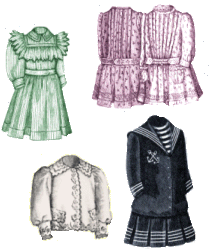 To start with, let's say that girls clothing
in the Victorian period is very different from the clothes worn in the 21st
century.
To start with, let's say that girls clothing
in the Victorian period is very different from the clothes worn in the 21st
century.
As a girl matures, her clothing changes are far less dramatic than in boys wear. Her garments utilize structured cloth stays which evolve into being created from bone as she ages. Her underpinnings are as numerous as her mother's. They include a chemise, stays, drawers and multiple starched petticoats. They also wear single boned "hoops" under their skirts.
The length of a girl's skirt changes depending on her age. As a toddler, the skirt length rises from ankle to mid-calf at approximately age 8, and then to boot top at age 11 or 12 and finally to ankle length upon reaching the age of 14 and up. Another sign of growing up is the change to a closed neckline and longer sleeves. At the age of 14, a girl wears short sleeves only for formal wear. Another significant change is from a back closure to a front closure on the dress. By the time she reaches 15, she is dressing in the same type of clothing as her mother.
Another characteristic is that the arm holes drop off the shoulder and shoulder seams fall toward the back of the shoulders. Popular styles of sleeves include the full bishop sleeve that gathers into a cuff, bell shape and pagoda.
Dress bodices consist of either close fitting jewel necklines or wide open necklines. Detachable white work collars are used to protect the dress. Most girls' dresses consist of one-piece matching top and bottoms, with the bodice gathered or pleated onto the waistband. The "skirt" of the dress features box pleats or knife pleats.
The most popular fabric used for girls clothing is cotton, wool and silks, with cotton calico being a staple. Wool is used for "good" dresses. Also, an important accessory for any girl is the "apron" or "pinafore".
Girls also have a variety of jacket styles including the rounded front bolero and the Zouave jacket which is heavily decorated in braiding. As mentioned above, by the time a girl reaches 15 she is typically wearing the same clothing as her mother. The only visible difference being in the length of the skirt if she is unmarried or very young looking.
|
|
|||
|
|
|
||
|
|
|
Back to Intro/Index or Site Map
| | Family Gallery | Servants Parlour | Tour Home | Typical Day | Etiquette | Shopping Trip | |
| | Victorian Christmas | Victorian England Fun and Games | Ashton Library | Victorian Wedding | |
| | Victorian England Overview | Guest Registry | Honorary Victorian | Tours | |
| | Awards Received | Bibliography | |
| | 1876 Victorian England Home | |
Credits below copyright information |
| Contact
webmaster |
| Copyright
1999-2017 All Rights Reserved - B. Malheiro May not be reproduced in any way without express written permission of webmaster. |
Credits:
Background set, buttons and "Girls Wear Department" are the creation of webmaster, B. Malheiro. These images have been digitally watermarked and are not for use on another site.